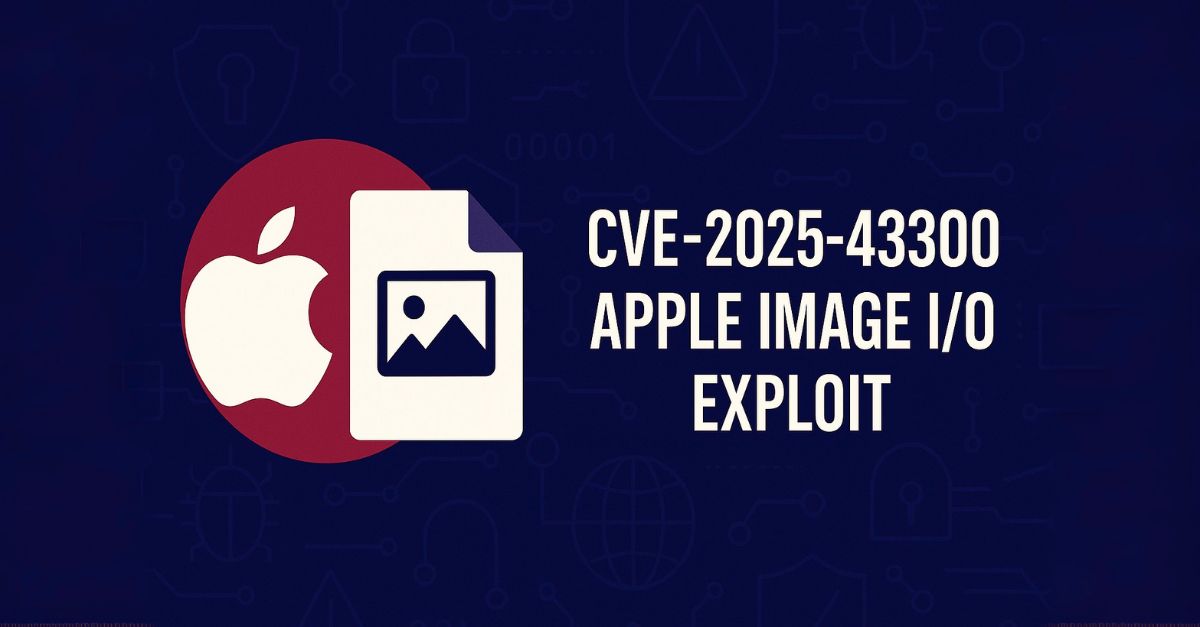CVE‑2025‑43300: Apple Image I/O Zero‑Day Exploit Targeting iOS and macOS Devices

CVE‑2025‑43300: Apple Image I/O Zero‑Day Exploit Targeting iOS and macOS Devices
A technical deep‑dive into an out‑of‑bounds write in Apple’s Image I/O that was exploited in the wild, enabling memory corruption and potential remote code execution.
Overview
On August 20, 2025, Apple released urgent security patches addressing CVE‑2025‑43300, a high‑severity out‑of‑bounds write vulnerability in the Image I/O framework. Apple confirmed active exploitation in what it described as an “extremely sophisticated attack” targeting specific individuals.
The flaw impacts a broad range of devices, including iPhone XS and later, multiple generations of iPad, and macOS systems running Ventura, Sonoma, and Sequoia. The issue stems from the way Image I/O processes maliciously crafted image files, leading to memory corruption and possible arbitrary code execution (RCE).
Operationally, this aligns with prior image‑based zero‑click exploit trends, where receiving or background‑processing an image can be enough to compromise a device.
iOS/iPadOS:
18.6.2 (and 17.7.10 for certain older models)macOS:
Sonoma 14.7.8, Ventura 13.7.8, Sequoia 15.6.1
How It Works
Image I/O is a core component used across iOS, iPadOS, and macOS to parse and render formats like JPEG, PNG, TIFF, GIF, BMP, and RAW. CVE‑2025‑43300 arises from insufficient bounds validation during parsing of a crafted image:
- When parsing adversarial inputs, the parser miscalculates buffer boundaries, resulting in an out‑of‑bounds write.
- This memory corruption can alter control flow, enabling RCE within the context of the process handling the image.
- Because Image I/O is invoked by numerous apps—Safari, Mail, Messages, preview services, and third‑party apps—the attack surface is wide.
- Interaction can be minimal; in some cases, thumbnail generation or metadata extraction can trigger the bug.
Apple’s fix introduces improved bounds checking to prevent writes beyond allocated memory regions.
Risks
- Remote Code Execution: Crafted images can deliver attacker‑controlled payloads.
- Zero‑/Low‑Click Exposure: Background parsing paths (thumbnails, previews, metadata) may trigger the flaw.
- Privilege Escalation Chains: When combined with sandbox escapes or kernel bugs, full device compromise is possible.
- Stealthy Espionage: High value for state‑sponsored or commercial spyware operations.
- Broad App Surface: Any consumer or enterprise app leveraging Image I/O can become an ingress point.
Real‑Life Example: Image‑Delivered Spyware Chain
Consider a targeted operator sending a single image via iMessage, email, or an enterprise collaboration app. The receiving app invokes Image I/O to extract metadata or render a preview. That background parse triggers the out‑of‑bounds write, granting initial code execution. A second‑stage payload then:
- Establishes persistence and collects device telemetry;
- Attempts sandbox or privilege escalation through a chained exploit;
- Exfiltrates sensitive data (messages, location, tokens, or key material) to a C2 endpoint.
This mirrors historic mobile spyware tradecraft, where carefully staged chains convert a single parsing bug into durable access on high‑value targets.
Recommendations
- Patch Immediately via OS updates:
- iOS/iPadOS: update to
18.6.2(or17.7.10where applicable). - macOS: update to
14.7.8(Sonoma),13.7.8(Ventura), or15.6.1(Sequoia). - Use MDM compliance policies to enforce deadlines and block non‑compliant devices.
- iOS/iPadOS: update to
- Enable Auto‑Updates to narrow the patch window exploited by threat actors.
- Hunt for Abuse:
- Review crashes or anomalies in image‑handling processes.
- Flag unusual outbound connections from endpoints following image delivery.
- Contain Fast: Isolate suspected endpoints, rotate credentials, and investigate for lateral movement.
- User Reporting: Encourage prompt reporting of unexpected images or unsolicited media attachments.
Conclusion
CVE‑2025‑43300 reinforces the continued weaponization of media parsers in low‑interaction exploit chains. Apple’s rapid patches highlight the severity and the likelihood of targeted operations. For defenders, assume endpoint exploitation attempts are ongoing, shorten your patch cycle, and invest in layered telemetry and response.
